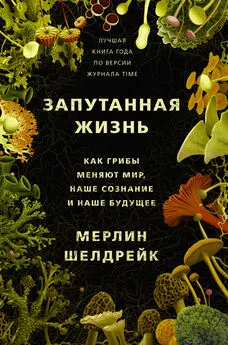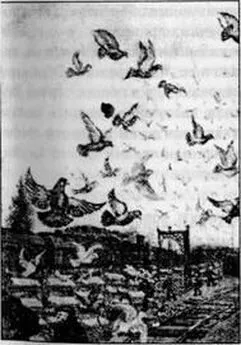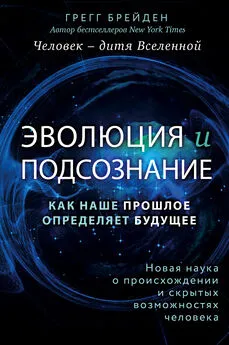Мерлин Шелдрейк - Запутанная жизнь. Как грибы меняют мир, наше сознание и наше будущее
- Название:Запутанная жизнь. Как грибы меняют мир, наше сознание и наше будущее
- Автор:
- Жанр:
- Издательство:Литагент АСТ
- Год:2021
- Город:Москва
- ISBN:978-5-17-122572-8
- Рейтинг:
- Избранное:Добавить в избранное
-
Отзывы:
-
Ваша оценка:
Мерлин Шелдрейк - Запутанная жизнь. Как грибы меняют мир, наше сознание и наше будущее краткое содержание
Талантливый молодой биолог Мерлин Шелдрейк переворачивает мир с ног на голову: он приглашает читателя взглянуть на него с позиции дрожжей, псилоцибиновых грибов, грибов-паразитов и паутины мицелия, которая простирается на многие километры под поверхностью земли (что делает грибы самыми большими живыми организмами на планете). Открывающаяся грибная сущность заставляет пересмотреть наши взгляды на индивидуальность и разум, ведь грибы, как выясняется, – повелители метаболизма, создатели почв и ключевые игроки во множестве естественных процессов. Они способны изменять наше сознание, врачевать тела и даже обратить нависшую над нами экологическую катастрофу. Эти организмы переворачивают наше понимание самой жизни на Земле.
В формате PDF A4 сохранен издательский макет.
Запутанная жизнь. Как грибы меняют мир, наше сознание и наше будущее - читать онлайн бесплатно ознакомительный отрывок
Интервал:
Закладка:
Watanabe S, Tero A, Takamatsu A, Nakagaki T. 2011. Traffic optimization in railroad networks using an algorithm mimicking an amoeba-like organism, Physarum plasmodium. Biosystems 105: 225–32.
Watkinson SC, Boddy L, Money N. 2015. The Fungi . London, UK: Academic Press.
Watts J. 2018. Scientists identify vast underground ecosystem containing billions of micro-organisms. The Guardian : www.theguardian.com/science/2018/dec/10/tread-softly-because-you-tread-on-23bn-tonnes-of-micro-organisms [accessed October 29, 2019].
Watts-Williams SJ, Cavagnaro TR. 2014. Nutrient interactions and arbuscular mycorrhizas: a meta-analysis of a mycorrhiza-defective mutant and wild-type tomato genotype pair. Plant and Soil 384: 79–92.
Wellman CH, Strother PK. 2015. The terrestrial biota prior to the origin of land plants (embryophytes): a review of the evidence. Palaeontology 58: 601–27.
Weremijewicz J, da Sternberg L, Janos DP. 2016. Common mycorrhizal networks amplify competition by preferential mineral nutrient allocation to large host plants. New Phytologist 212: 461–71.
Werner GD, Kiers TE. 2015. Partner selection in the mycorrhizal mutualism. New Phytologist 205: 1437–442.
Werner GD, Strassmann JE, Ivens AB, Engelmoer DJ, Verbruggen E, Queller DC, Noë R, Johnson N, Hammerstein P, Kiers TE. 2014. Evolution of microbial markets. Proceedings of the National Academy of Sciences 111: 1237–244.
Werrett S. 2019. Thrifty Science: Making the Most of Materials in the History of Experiment . Chicago, IL: University of Chicago Press.
West M. 2019. Putting the “I” in science. Nature : www.nature.com/articles/d41586-019-03051-z [accessed October 29, 2019].
Westerhoff HV, Brooks AN, Simeonidis E, García-Contreras R, He F, Boogerd FC, Jackson VJ, Goncharuk V, Kolodkin A. 2014. Macromolecular networks and intelligence in microorganisms. Frontiers in Microbiology 5: 379.
Weyrich LS, Duchene S, Soubrier J, Arriola L, Llamas B, Breen J, Morris AG, Alt KW, Caramelli D, Dresely V, et al. 2017. Neanderthal behaviour, diet, and disease inferred from ancient DNA in dental calculus. Nature 544: 357–61.
Whiteside MD, Werner GDA, Caldas VEA, Van’t Padje A, Dupin SE, Elbers B, Bakker M, Wyatt GAK, Klein M, Hink MA, et al. 2019. Mycorrhizal fungi respond to resource inequality by moving phosphorus from rich to poor patches across networks. Current Biology 29: 2043–50.
Whittaker R. 1969. New Concepts of Kingdoms of Organisms. Science 163: 150–60.
Wiens F, Zitzmann A, Lachance M-A, Yegles M, Pragst F, Wurst FM, von Holst D, Guan S, Spanagel R. 2008. Chronic intake of fermented floral nectar by wild treeshrews. Proceedings of the National Academy of Sciences 105: 10426–431.
Wilkinson DM. 1998. The evolutionary ecology of mycorrhizal networks. Oikos 82: 407–10.
Willerslev R. 2007. Soul Hunters: Hunting, Animism, and Personhood among the Siberian Yukaghirs . Berkeley, CA: University of California Press.
Wilson GW, Rice CW, Rillig MC, Springer A, Hartnett DC. 2009. Soil aggregation and carbon sequestration are tightly correlated with the abundance of arbuscular mycorrhizal fungi: results from long-term field experiments. Ecology Letters 12: 452–61.
Winkelman MJ. 2017. The mechanisms of psychedelic visionary experiences: hypotheses from evolutionary psychology. Frontiers in Neuroscience 11: 539.
Wipf D, Krajinski F, Tuinen D, Recorbet G, Courty P. 2019. Trading on the arbuscular mycorrhiza market: from arbuscules to common mycorrhizal networks. New Phytologist 223: 1127–142.
Wisecaver JH, Slot JC, Rokas A. 2014. The evolution of fungal metabolic pathways. PLOS Genetics 10: e1004816.
Witt P. 1971. Drugs alter web-building of spiders: a review and evaluation. Behavioral Science 16: 98–113.
Wolfe BE, Husband BC, Klironomos JN. 2005. Effects of a belowground mutualism on an aboveground mutualism. Ecology Letters 8: 218–23.
Wright CK, Wimberly MC. 2013. Recent land use change in the Western Corn Belt threatens grasslands and wetlands. Proceedings of the National Academy of Sciences 110: 4134–139.
Wulf A. 2015. The Invention of Nature . New York, NY: Alfred A. Knopf.
Wyatt GA, Kiers TE, Gardner A, West SA. 2014. A biological market analysis of the plant-mycorrhizal symbiosis. Evolution 68: 2603–618.
Yano JM, Yu K, Donaldson GP, Shastri GG, Ann P, Ma L, Nagler CR, Ismagilov RF, Masmanian SK, Hsiao EY. 2015. Indigenous bacteria from the gut microbiota regulate host serotonin biosynthesis. Cell 161: 264–76.
Yon D. 2019. Now You See It. Quanta : aeon.co/essays/how-our-brain-sculpts-experience-in-line-with-our-expectations? [accessed October 29, 2019].
Yong E. 2014. The Guts That Scrape The Skies. National Geographic : www.nationalgeographic.com/science/phenomena/2014/09/23/the-guts-that-scrape-the-skies/ [accessed October 29, 2019].
Yong E. 2017. How the Zombie Fungus Takes Over Ants’ Bodies to Control Their Minds. The Atlantic : www.theatlantic.com/science/archive/2017/11/how-the-zombie-fungus-takes-over-ants-bodies-to-control-their-minds/545864/ [accessed October 29, 2019].
Yong E. 2016. I Contain Multitudes: The Microbes Within Us and a Grander View of Life . New York, NY: Ecco Press.
Yong E. 2018. This Parasite Drugs Its Hosts With the Psychedelic Chemical in Shrooms. The Atlantic : www.theatlantic.com/science/archive/2018/07/massospora-parasite-drugs-its-hosts/566324/ [accessed October 29, 2019].
Yong E. 2019. The Worst Disease Ever Recorded. The Atlantic : www.theatlantic.com/science/archive/2019/03/bd-frogs-apocalypse-disease/585862/ [accessed October 29, 2019].
Young RM. 1985. Darwin’s Metaphor . Cambridge, UK: Cambridge University Press.
Yuan X, Xiao S, Taylor TN. 2005. Lichen-like symbiosis 600 million years ago. Science 308: 1017–20.
Yun-Chang W. 1985. Mycology in Ancient China. Mycologist 1: 59–61.
Zabinski CA, Bunn RA. 2014. “Function of Mycorrhizae in Extreme Environments.” In Mycorrhizal Fungi: Use in Sustainable Agriculture and Land Restoration . Solaiman Z, Abbott L, Varma A, eds. Springer International Publishing, pp. 201–14.
Zhang MM, Poulsen M, Currie CR. 2007. Symbiont recognition of mutualistic bacteria by Acromyrmex leaf-cutting ants. The ISME Journal 1: 313–20.
Zhang S, Lehmann A, Zheng W, You Z, Rillig MC. 2019. Arbuscular mycorrhizal fungi increase grain yields: a meta-analysis. New Phytologist 222: 543–55.
Zhang Y, Kastman EK, Guasto JS, Wolfe BE. 2018. Fungal networks shape dynamics of bacterial dispersal and community assembly in cheese rind microbiomes. Nature Communications 9: 336.
Zheng C, Ji B, Zhang J, Zhang F, Bever JD. 2015. Shading decreases plant carbon preferential allocation towards the most beneficial mycorrhizal mutualist. New Phytologist 205: 361–68.
Zheng P, Zeng B, Zhou C, Liu M, Fang Z, Xu X, Zeng L, Chen J, Fan S, Du X, et al. 2016. Gut microbiome remodeling induces depressive-like behaviors through a pathway mediated by the host’s metabolism. Molecular Psychiatry 21: 786–96.
Zhu K, McCormack LM, Lankau RA, Egan FJ, Wurzburger N. 2018. Association of ectomycorrhizal trees with high carbon-to-nitrogen ratio soils across temperate forests is driven by smaller nitrogen not larger carbon stocks. Journal of Ecology 106: 524–35.
Zhu L, Aono M, Kim S-J, Hara M. 2013. Amoeba-based computing for traveling salesman problem: Long-term correlations between spatially separated individual cells of Physarum polycephalum. Biosystems 112: 1–10.
Zobel M. 2018. Eltonian niche width determines range expansion success in ectomycorrhizal conifers. New Phytologist 220: 947–49.
Иллюстрации

Кайка, собака породы лаготто-романьоло, охотница за трюфелями. Фото автора
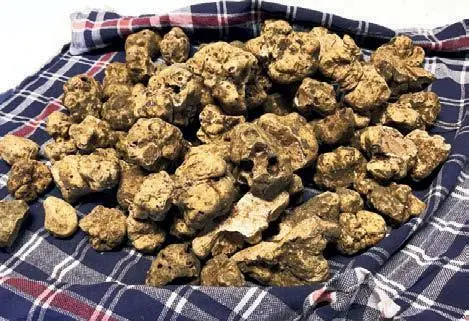
Пьемонтские белые трюфели, Tuber magnatum . Фото автора
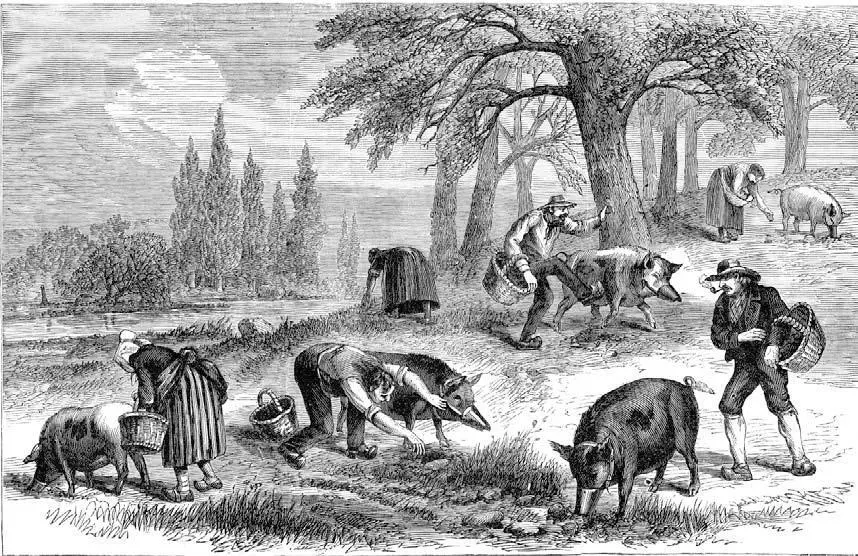
«Охота за трюфелями. Обученные свиньи роют землю в поисках драгоценных съестных припасов». Иллюстрация из книги, опубликованной ок. 1890 г. На свиньях специальные намордники, должные помешать им полакомиться находками. Фото Samantha Vuignier/Corbis via Getty Images
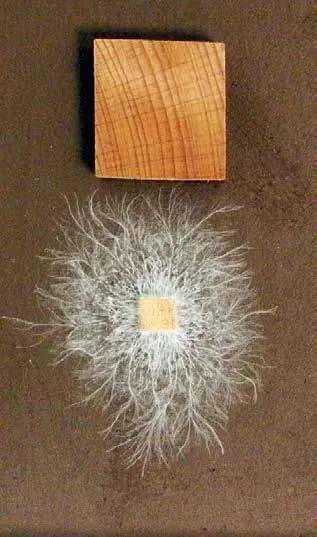
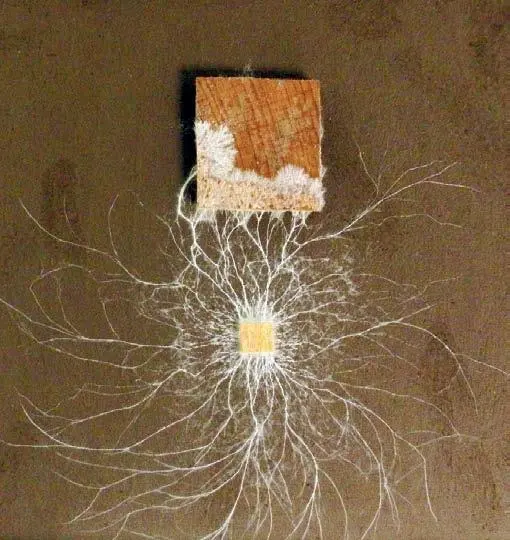
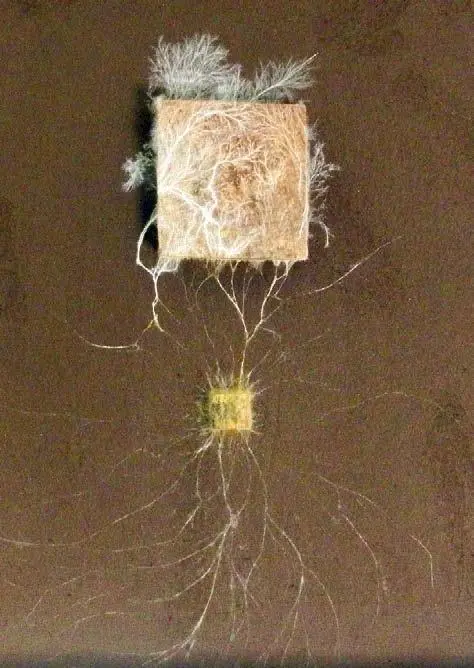
Пищевое поведение вызывающего белую гниль древесины гриба Phanerochaete velutina .
Первое и последнее фото разделяют 48 дней. Мицелий начинает исследовать поверхность во всех направлениях. Обнаружив пропитание, гриб усиливает гифы, соединяющие со съестным, тогда как никуда не ведущие гифы отмирают.
Фото Yu Fukasawa
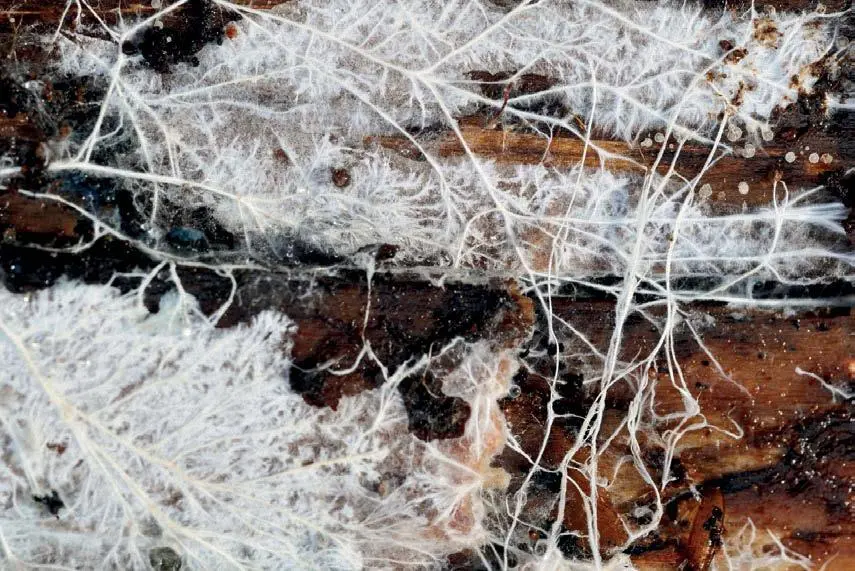

Мицелий домового гриба, изучающий и поглощающий полено. Фото Alison Pouliot

Хлебный плесневый грибок нейроспора густая, Neurospora crassa , проходящий микроскопический лабиринт. Черными стрелками помечено направление роста в местах ветвления и на входе.
Изображение воспроизводится по изданию Held, et al. (2010)
Читать дальшеИнтервал:
Закладка:
